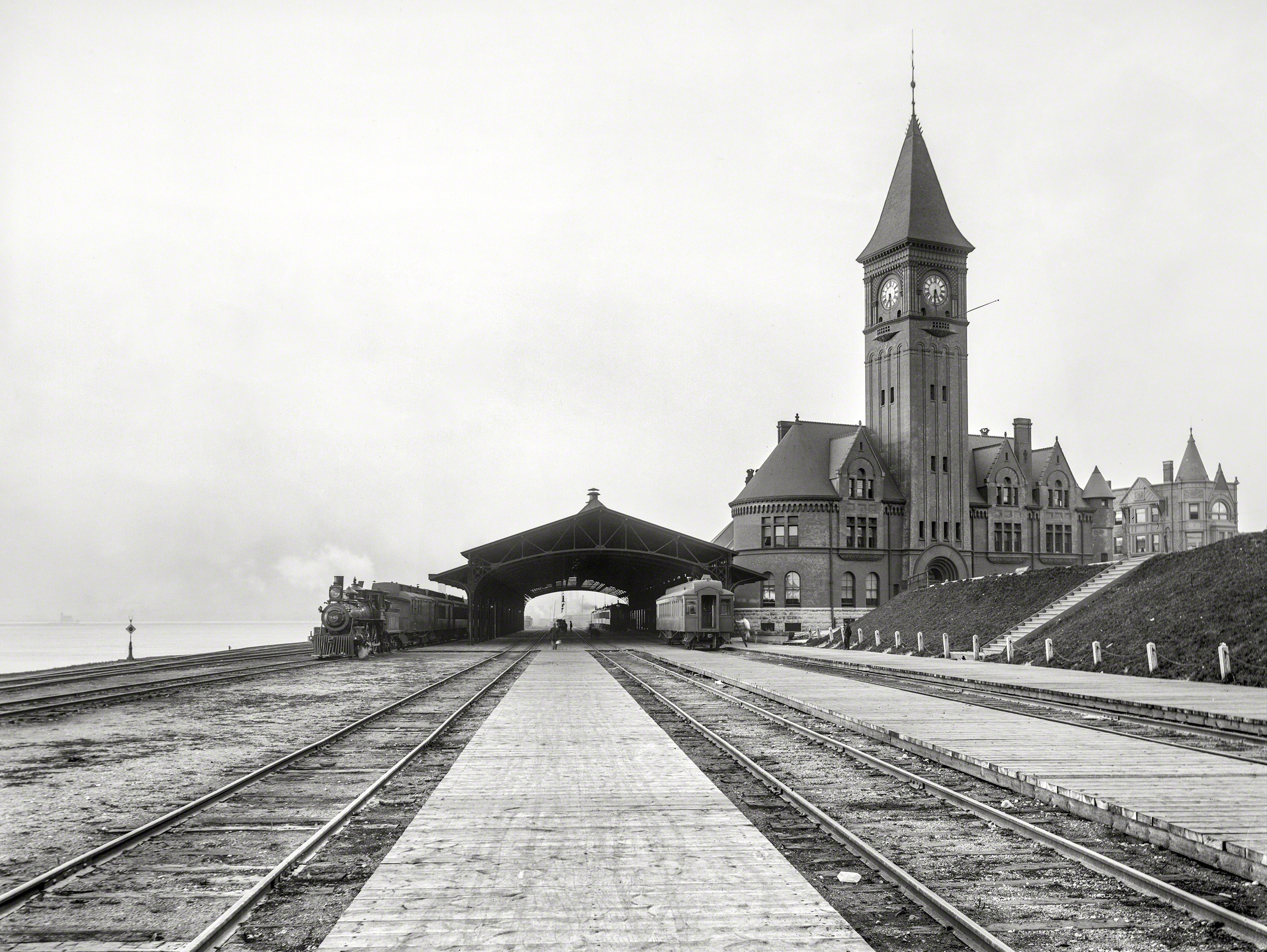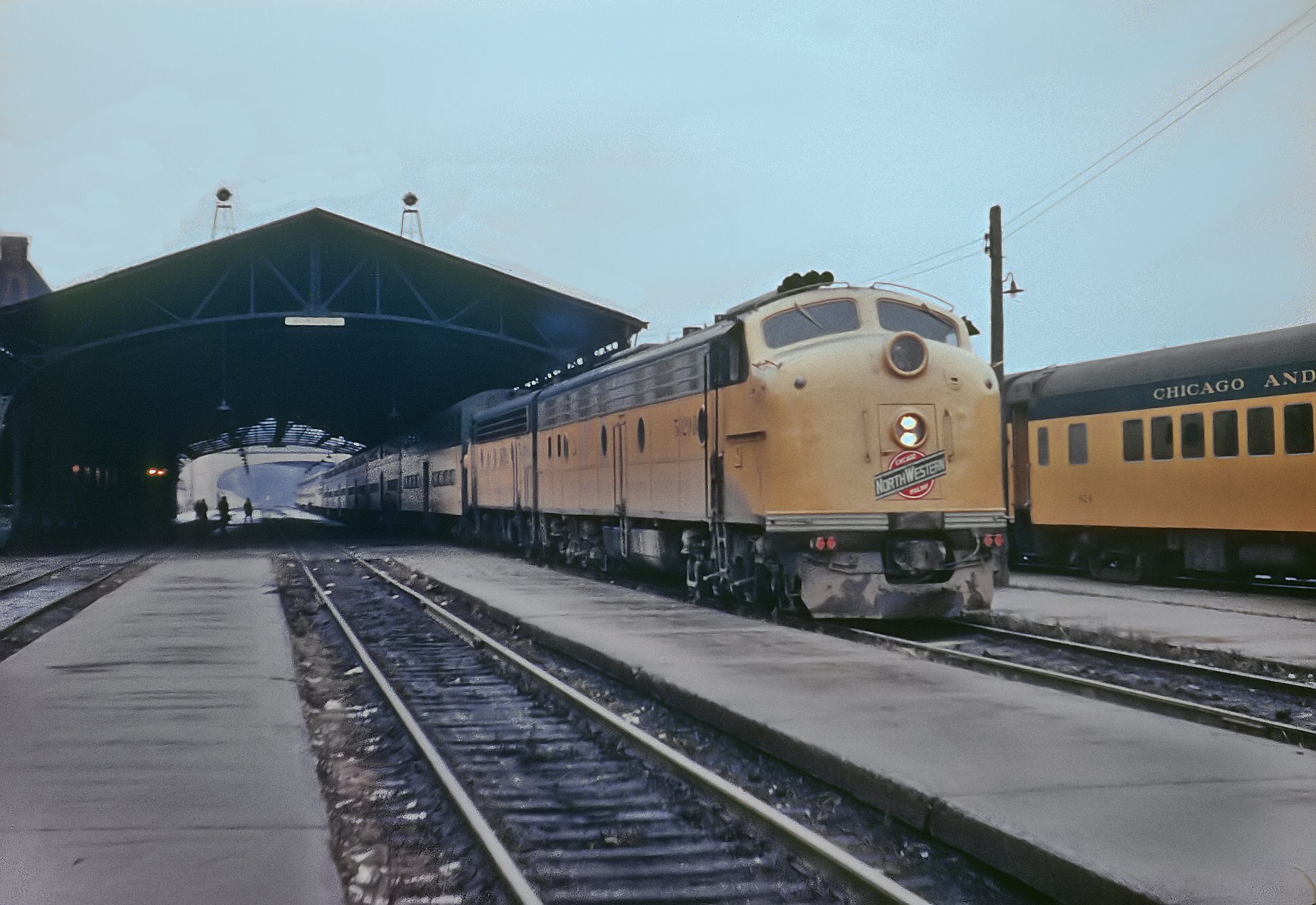Lake Front Depot: The C&NW's Milwaukee Terminal
Last revised: September 9, 2024
By: Adam Burns
The Lake Front Depot was a beautiful and significant train station in Milwaukee, Wisconsin that was perched right along the waterfont at 918 East Wisconsin Avenue.
Built in 1889, it was a hub for the Chicago and North Western Railway until it was demolished in 1968. The depot was known for its architectural grandeur, featuring a clock tower, a grand waiting room, and a distinctive Victorian Gothic design.
Despite its historical significance, the depot was demolished in the 1960s after the C&NW moved its remaining passenger trains over to the newly opened Milwaukee Union Station in 1966, a facility completed by the Milwaukee Road the previous year.
 An early view of Chicago & North Western's Lake Front Depot in Milwaukee taken by the Detroit Publishing Company in 1899.
An early view of Chicago & North Western's Lake Front Depot in Milwaukee taken by the Detroit Publishing Company in 1899.Construction
The Lake Front Depot in Milwaukee, constructed by the Chicago and North Western (CNW) Railway, was an incredible architectural triumph of the era. The awe-inspiring train station, with its spacious halls and eclectic architectural features, swiftly etched an indelible mark on Milwaukee's history.
Charles Sumner Frost
The credit for the delicate yet grand design of the Lake Front Depot belongs to Charles Sumner Frost, an acclaimed architect of the 19th century. Particularly known for his railway station designs, Frost's ingenious creativity found expression in the fascinating architectural intricacy of the Depot.
Officially opened to the public on May 13, 1889, the Lake Front Depot was an iconic underpinning of Milwaukee's railway infrastructure. Its establishment symbolized the city's robust passion for the railway industry and its commitment to expanding railway connectivity.
Cost
The cost to build this architectural marvel was estimated at $300,000, according to the currency values of that era. This substantial investment exemplified Milwaukee's faith in and dedication to the development of its railway system, demonstrating its drive for progressive growth.
Frost, in his unique architectural style, designed the Lake Front Depot in the Neo-Classical architectural style. The inclusion of classical architectural elements conveyed ideas of power, wealth, and cultural sophistication, aligning with the C&NW's aspirations and the city's narrative.
Lake Superior Sandstone was specifically chosen as the primary construct material for the Depot. The beige and brown tones of the sandstone graced the Depot with a certain rugged elegance.
Shaped by Frost's masterful hands, the Lake Front Depot marked its territory at the lakefront area of downtown Milwaukee, specifically at the end of East Wisconsin Avenue. This central location placed the depot at the heart of the city, making it an accessible and convenient hub for commuters.
The depot, in all its grandeur, facilitated rail transportation via three major railroad tracks accompanied by spacious platforms. Designed to ensure efficient movement of passengers and goods, these tracks represented the evolving concept of mass transit during the era.
During its peak years, the Lake Front Depot was bustling with activity. With around 76 trains mark their way through its rail tracks daily, the depot serviced a staggering number of about 3000 passengers per day. This impressive number underlined the central role Lake Front Depot played in passengers' lives and Milwaukee’s overall transportation ecosystem.
The C&NW's famed '400' streamliners, synonymous with speed and luxury, stopped at this terminal; names like the Dakota '400', Twin Cities '400', Peninsula '400', and Shoreland/Valley '400'.
Closure and Demolition
In August, 1965, the Milwaukee Road closed its beautiful Everett Street Station facility and moved remaining passenger services to its newly constructed Milwaukee Union Station. The C&NW did the same the following year.
The date, July 31, 1966, signaled the end of an era, as the depot closed its doors to the public. The closing was a consequence of changes in transportation modalities and socio-economic shifts; by that time much of the traveling public was utilizing either highways or airlines for long distance tarvel.
Despite the station's immense historical value, the Lake Front Depot was demolished on October 25, 1968. Barely two years after its closure, the demolition marked a poignant culmination of the Depot's vibrant, decades-long existence.
The facility's demolition, and that of Everett Street, caused the city of Milwaukee to reevaluate its stance on allowing such historically significant buildings to be demolished.
 Chicago & North Western E8A #5029B has train #214, the "Peninsula '400'," at the Lake Front Depot trainsed in June, 1966. Rick Burn photo.
Chicago & North Western E8A #5029B has train #214, the "Peninsula '400'," at the Lake Front Depot trainsed in June, 1966. Rick Burn photo.Legacy
Although physically removed, the depot's influence persists. Its footprints have imprinted a path of development and evolution onto Milwaukee's urban landscape.
The depot was an institution that encapsulated the essence of the C&NW and city of Milwaukee. Its significance transcended beyond its function as a transit station; it was an iconic landmark that narrated the stories of people, places, and changes. Beyond being a hub of activity and travel, it symbolized Milwaukee's spirit.
In recalling the bustling scene of passengers boarding the '400' streamliners at the depot, one can imagine the rhythm of a rapidly evolving city. The thrilling anticipation, the blend of faces, the adrenaline rush- all woven into the tapestry of Milwaukee's socio-economic narrative.
With the highway era dawning and the rise in popularity of air travel, the depot's significance began to dwindle. Reduced patronage and profitability eventually led to its closure, a challenging yet inevitable step in the face of the socio-economic transformations of the time.
However, the absence of the facility does not nullify its historic contributions. It serves as a testament to the era when the C&NW, with all its grandeur, set the stage for an exciting chapter in Milwaukee's development.
Today, there are no rails along Milwaukee's Lower East Side or within the Historic Third Ward. Where the depot once stood is now home to the Milwaukee Art Museum. It is truly difficult today to imagine a railroad ever passed through this area of the city.
The story of the Lake Front Depot is layered with nuances and complexities. It presents a dynamic chronicle of people, progress, and dreams held together by the steel tracks of the C&NW, crafting a socio-historical narrative that is as integral to Milwaukee as its own cityscape.
The depot was more than an architectural marvel credited to Frost. It was the nucleus from where the threads of connection spread across Milwaukee and beyond, illustrating the transformative power of effective rail transportation.
The rise and fall of the Lake Front Depot mirror Milwaukee's own journey. It's a trajectory characterized by periods of flourish and decline, punctuated by constant adaptation and transformation. Through its silent existence, and eventual disappearance, the facility provides crucial insights into Milwaukee's urban evolution.
Whether one hears the blaring horns of the '400' streamliners or the subtle whisperings of travelers, the depot brought people, dreams, and destinations together. It was an integral element of Milwaukee's socio-economic fabric, propelling the city to previously unexplored thresholds of development.
The terminal may have physically disappeared, but it continues to be a living entity within Milwaukee's urban memory. With its legacy immortalized in Milwaukee's history, the echo of the last '400' streamliner departing from its platform continues to resonate across the city.
To understand Milwaukee's railway history fully, looking back at the Lake Front Depot's contributions is fundamental. The depot was a colossal symbol of the city's faith in the C&NW and an embodiment of its love affair with rail travel. Tracing back to its creation, glory days, and eventual disappearance offers a vivid picture of Milwaukee's railway scene.
The erstwhile Lake Front Depot symbolizes the constant ebb and flow of life within a city. Today, as Milwaukee rides on the thermals of new-age progress, the grounding echoes of the Lake Front Depot serve as a reminder of its vibrant past.
The fusion of these different timelines, past and present, crafts the narrative of this ever-evolving city. In the landscape of time, the Lake Front Depot is a poignant chapter in the book titled 'Milwaukee' – a chapter of ambition, growth, and transformation.
Recent Articles
-
Massachusetts - Wine Tasting - Train Rides
Dec 26, 25 03:37 PM
This article dives into some of the alluring aspects of wine by rail in Massachusetts, currently offered by the Cape Cod Central Railroad. -
Maryland - Wine Tasting - Train Rides
Dec 26, 25 03:34 PM
This article delves into the enchanting world of wine tasting train experiences in Maryland, providing a detailed exploration of their offerings, history, and allure. -
Florida Thomas The Train Rides
Dec 26, 25 03:32 PM
Each year, Day Out With Thomas™ turns the Florida Railroad Museum in Parrish into a full-on family festival built around one big moment: stepping aboard a real train pulled by a life-size Thomas the T…



